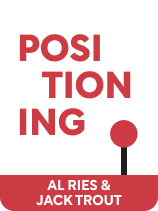

This article is an excerpt from the Shortform book guide to "Positioning" by Al Ries and Jack Trout. Shortform has the world's best summaries and analyses of books you should be reading.
Like this article? Sign up for a free trial here .
Have you read the marketing book Positioning? What wisdom does it hold for you and your business?
In the book Positioning: The Battle for Your Mind, Al Ries and Jack Trout discuss what it means to successfully position your product in a competitive marketplace. They also share three guidelines for influencing how your customers perceive your product.
Keep reading to learn these marketing concepts presented in the book Positioning.
The Battle for Your Mind: Insights From the Book Positioning
In Positioning: The Battle for Your Mind, advertising consultants Al Ries and Jack Trout bring more than 20 years of marketing experience to the concept of positioning—a strategy of framing your product, service, company, or self against your competitors and within your market. The authors primarily focus on how to use positioning to market a product or service, but they also provide some tips on advancing your career by using similar strategies to position yourself as a professional.
Positioning was originally published in 1981 and was the first of several collaborations between the authors, who are credited with popularizing the concept of positioning as a marketing strategy. They’ve written several other books together since then, including Marketing Warfare, Bottom-Up Marketing, and The 22 Immutable Laws of Marketing, and are regarded as some of the world’s best-known experts on marketing strategy.
What Is Positioning?
According to Ries and Trout, “positioning” is getting your prospective customers to view your product in a certain way relative to competing products and the general market landscape. The “position” of a product is its basic identity in the mind of potential consumers in contrast to other products.
For example, when you think of a Ferrari, you think of an expensive, high-end sports car. When you think of a Corvette, you think of an iconic sports car that’s still expensive, but more affordable than a Ferrari. These mental images are the “positions” that Ferrari and Corvette occupy in your mind.
(Shortform note: Ries and Trout define positioning primarily as an action (what you do to influence the customer’s perceptions), and they use the word to cover the results (the customer’s actual perception of your product) by extension. Other sources reverse this approach, defining positioning primarily as the customer’s actual perception of your product, and secondarily as what you do to influence their perceptions. Marketing consultant Geoffrey Moore views positioning by this definition, insisting that your customers position your product, while you merely try to influence them.)
What Does Positioning Look Like?
Mostly, positioning takes the form of advertising. The book Positioning points out that advertising is just a means of communication. To position your product, you have to communicate a message that influences how people think about it, especially in relation to other products.
However, they also point out that advertising is often an unwelcome form of communication: We are bombarded with so many ads from so many different sources that we can’t possibly pay attention to all of them, and so we filter out most of them.
(Shortform note: Marketing experts have long noted that in order to prevent your message from getting filtered out, you must appeal to your customers’ “unconscious mind.” In Blink, Malcolm Gladwell explains how your intuition (your unconscious mind) has evolved to sift through information, picking out what is relevant and discarding the rest so you can focus on only what truly matters in any given situation. Because our minds work this way, your marketing message must be tailored to speak to your customers’ intuition, rather than their analytical minds.)
3 Guidelines for Positioning-Based Advertising
The book Positioning advises that, to penetrate your customer’s mental filter and influence their perception of your product, your ads need to do three things:
1. Over-simplify the message. According to Ries and Trout, most people overlook the best positioning strategies because they seem too simple and obvious, but the authors contend that the simpler the message, the better, because simpler messages can more easily get through your brain’s information-overload filter.
The authors explain that simplicity matters so much because your brain can only store and process a few ideas at once, and it thus ignores anything that would exceed its capacity. As evidence, they cite psychological research on the brain’s limitations, such as psychologist George Miller’s discovery that the human working memory can only hold about seven pieces of information at a time.
(Shortform note: More recent research indicates that simplicity might be even more important than the authors originally supposed. Miller’s “seven pieces” discovery has been superseded by studies suggesting that working memory capacity is even smaller: It’s likely around four pieces of information, and perhaps as little as two. This means Ries and Trout’s ideas are even more important to get right, as the margin of error for your message to get through is even less than they imagined.)
2. Reflect reality as your customer understands it. The book Positioning asserts that our expectations shape our perceptions: We are more likely to accept a message that fits with what we already know or accept to be true, and we’re more likely to ignore a message that goes against it.
(Shortform note: Psychologists refer to this tendency as “confirmation bias.” Psychologist Raymond Nickerson, who studied this phenomenon extensively, concluded that it is practically universal, affecting individuals, groups, cultures, and nations. He added the wry caveat, however, that he could not rule out the possibility that his own conclusion might also be tainted by confirmation bias.)
3. Present a consistent message over time. According to the book Positioning, positioning is a long-term proposition, because people don’t like to change their minds. Over time, you’ll need to update your ads to keep them fresh, but you should stick to the same basic message to maintain your position.
(Shortform note: Today this directive is arguably more difficult to execute because investors and shareholders encourage businesses to focus on short-term growth to realize quick profits. As Ries and Trout explain, effective positioning is a long-term investment. Making that investment wisely by maintaining a consistent positioning stance can be an uphill battle in a business environment that rewards short-term gains instead.)

———End of Preview———
Like what you just read? Read the rest of the world's best book summary and analysis of Al Ries and Jack Trout's "Positioning" at Shortform .
Here's what you'll find in our full Positioning summary :
- A strategy of framing your product, service, company, or self against your competitors
- How to use the concept of positioning to further your career development
- Harmful positioning strategies you should avoid






